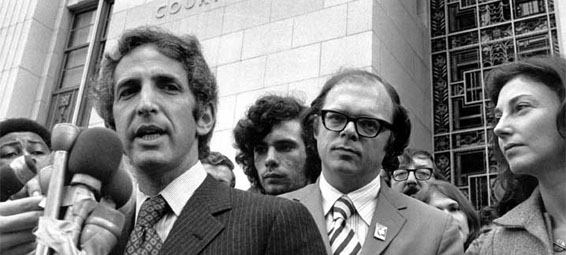Pardon my youthful admission: in the wake of the Iraq war and the illustrious Bush years, each time I see some snippet of historical footage or commentary from the Vietnam War (and the even more illustrious Nixon years) I am surprised anew at just how fragile American social order and the principles of democracy seemed back then. Case in point: The Most Dangerous Man in America: Daniel Ellsberg and the Pentagon Papers, Judith Ehrlich and Rick Goldsmith’s documentary about the Pentagon and Rand Corporation insider who went from Vietnam War hawk to anti-war information leaker. The Most Dangerous Man in America is a compelling political film because it focuses on the story of the man at the center of the intrigue, Daniel Ellsberg, and takes us through his decades-long transition from a war-supporter to protestor.
Ellsberg was a brilliant and educated Marine commander who was recruited to join the Rand Corporation in the early 1960s to research decision making in times of war. His work led him to the Pentagon, where he was in charge of gathering information from military commanders on the ground in Vietnam to help support the cause of war. Eventually Ellsberg’s conscience caught up with him. In 1970 Ellsberg smuggled a massive document – the Pentagon Papers, as they came to be called – out of the classified safe in his office and began distributing copies to public officials and eventually newspapers, exposing the lies that made up the case for war in Vietnam. The leak contributed greatly to bringing the war to a close.
Aided to a great extent by much original source footage and recordings, including Nixon’s own Oval Office recordings which feature in the film, Ehrlich and Goldsmith recreate the feeling of paranoia and helplessness that shrouded the nation at the time. In a particularly chilling scene, Ellsberg recalls how a single phone call with a colonel in Vietnam regarding abuse to American soldiers almost single-handedly gave White House Officials the evidence used to justify escalating the conflict. The documentary is filled with similarly fascinating behind the scenes anecdotes. Ellsberg recalls a conversation with Robert McNamara about the stalling progress in Vietnam, after which Ellsberg was hopeful that McNamara agreed that the war was un-winnable. Moments later, Ellsberg watches the defense secretary lie to television cameras, proclaiming steady progress on the ground. These stories expose the horror of a government steeped in a cloak of lies, running a war “to save face,” as McNamara admits in one section of the Pentagon Papers. But it also reveals Ellsberg as a figure vital to both starting and ending the Vietnam War, a drama so bold you could barely dream it up.
The Most Dangerous Man in America works as a companion piece to Errol Morris’s fantastic documentary The Fog of War (2003), in which Robert McNamara, his own conscious also heavy after all these years, takes the viewer through the complicated decision making that lead to the Vietnam disaster. Both films let the audience in on government secrets that seem as colorful and improbably as the most exciting Hollywood script. Only unlike Hollywood, the documentary makes you start wondering about the secrets hidden within our government today. After the film ends, the paranoia sets in.





